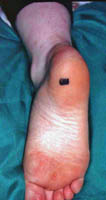
Typical site of plantar fasciitis pain - the anteromedial aspect of the heel
History
The characteristic complaint is of pain under the medial aspect of the heel, typically worst on the first step in the morning, improving as the day goes on then often getting more painful towards evening. Some patients have more weightbearing pain than first step pain. The pain may radiate across the heel or down the plantar fascia.
Tingling, electric shocks, altered sensation and rest pain should suggest nerve entrapment - tarsal tunnel syndrome, nerve to quadratus plantae, medial calcaneal nerves.
All patients should be asked about symptoms suggestive of a spondyloarthropathy such as ankylosing spondylitis: other inflamed joints or tendon attachments, inflammatory back pain, iritis, blood or mucus per rectum, urethritis, skin problems especially psoriasis.
A history of trauma or recent increase in physical activity should suggest acute or stress fracture of the calcaneum.
Many patients have had the problem for a long time - over a year is not unusual - and may have had a variety of treatments. However, it is rare to see a patient who has had plantar fascitis for over 3 years at presentation - whether the conditions resolves or patients adjust to it is unknown.
Patients have often had their symptoms explained to them in terms of a "spur" and may assume that they just need the spur removed and all will be well.
Examination
Typical physical findings are localised tenderness under the medial calcaneal tubercle and sometimes in the proximal plantar fascia, sometimes worse on toe dorsiflexion (the windlass test). There is usually reduced ankle dorsiflexion due to a tight Achilles tendon - this may only be relatively reduce compared with the other side. The patient is often obese.
The patient's hindfoot position and general foot shape and mobility should be noted.
Generalised heel tenderness is not typical of plantar fascitis and should usually exclude the diagnosis - the usual causes of this are plantar fat pad atrophy, previous calcaneal fracture and nonspecific pain.
Differential diagnosis
Patients with Achilles tendon pathology may be referred as "heel pain" but the different site of pain and tenderness is usually obvious. Achilles tendonopathy and plantar fascitis coexist more often than would be expected by chance (Gibbon and Long 1999).Tenderness, hypersensitivity and a positive Tinel test should be sought over the tarsal tunnel, the nerve to quadratus plantae and the medial calcaneal nerves. Tenderness over the calcaneum itself may indicate a stress fracture. The ankle and subtalar joints should be examined - occasionally referred pain from an arthritic joint is felt under the heel. The tibialis posterior tendon should be examined. The local skin should also be searched for evidence of penetrating trauma.
